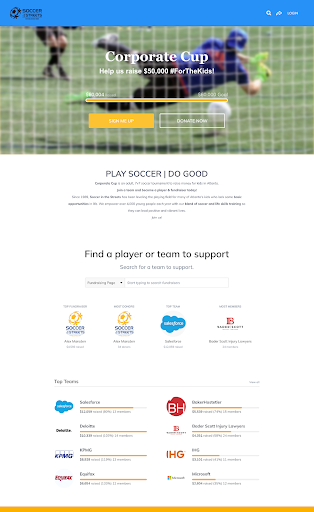How to Leverage Team Fundraising to Engage Corporate Partners

Request a Demo
Learn how top nonprofits use Classy to power their fundraising.
One of the many benefits of a peer-to-peer fundraising platform is that it allows your nonprofit to kick up engagement and excitement through team fundraising. This ability to foster friendly competition among participants can benefit any of your campaigns, but it becomes especially powerful when you leverage it to attract corporate partners.
Soccer in the Streets, an organization that uses the sport to cultivate young leaders and healthy communities, executes this strategy with their annual Corporate Cup peer-to-peer campaign. Their recent Corporate Cup engaged top companies like Salesforce, Deloitte, and Microsoft and raised over $60,000, despite the challenges presented by the pandemic.
We had the opportunity to sit down with Community Engagement Manager Erik Nelson to break down how the organization engages and motivates participants throughout the duration of their campaign. Dive into these insights below and apply them to activate corporate partners for your own nonprofit through team peer-to-peer fundraising.
Download Your Peer-to-Peer Campaign Checklist
When and How to Recruit Corporate Partners for Team Fundraising
While Soccer in the Streets’ other peer-to-peer campaigns typically activate team captains from within their community to recruit players and participants, the Corporate Cup taps into corporate giving programs and activates each business as a fundraising team.

The organization promotes the campaign as an opportunity for businesses to create an external team-building experience for their staff, while also offering a fun way to compete against other corporations in similar industries.
Soccer in the Streets typically reaches out to companies about 15 to 17 weeks prior to the external campaign launch to gauge and generate interest and involvement.
“When it comes to asking corporations to get involved, phone the decision-makers within the company. Share that this opportunity is fun at the very least, and it’s a chance for the company to get their team out there.
Communicate how this campaign can engage employees to make a social impact, as well as curate further excitement by fostering healthy competition against other companies. If they’re unable to participate in the team fundraising, ask if they would consider making a one-time donation to the campaign. This was an alternative option that came in especially handy for Soccer in the Streets when it was harder to get full buy-in compared to previous years due to the pandemic.
Appoint Team Captains
For their other peer-to-peer campaigns, Soccer in the Streets usually selects previous top fundraisers as their team captains. These individuals are not only already bought into the cause, but they naturally set an example for other participants to hustle and crush their fundraising goals.
The team captains for their Corporate Cup, however, typically are the main contacts from each company for the campaign. That being said, you can still provide these individuals with strategies and tips to further rally and motivate their staff to get involved. Read our blog post to learn how an employee at Classy was able to engage our own staff members to collectively raise $72,000 in a previous campaign.
8 Ways to Make It Easy for Fundraisers to Crush Their GoalsCommunication Tips for Team Fundraising
Soccer in the Streets attributes much of the success of their team fundraising campaigns to their consistent communications.
Start Weekly Communications
The organization has typically begun communications about 15 weeks out to encourage people to create their personal fundraising pages, but Erik notes they’re considering changing up this timeline based on feedback from some participants.
“We’ve been finding out that [15 weeks out] has felt like a bit of communication overload for some fundraisers, so we’ve been playing around with starting communications 12 or 10 weeks out,” said Erik. “Most people will usually wait until about 6 weeks out to start their campaigns, but these early messages help them understand there will be steady communications, as well as give them access to weekly stories or updates.”
The organization then begins sending two messages per week starting 6 to 7 weeks out, as that’s the period when they typically see a spike in activity.
One of the main takeaways here is to keep an eye on the data to build and optimize a communications timeline that’s tailored to your own community’s behavior. Refer back to past campaigns to help build a starting point, and continue to monitor your findings to further inform your outreach frequency and timeline.
Your Guide to Peer-to-Peer Fundraising Emails
Share Tools, Vary Content, and Test Your Format
Soccer in the Streets packs their communications with meaningful content like impact stories, testimonials and highlights of heavy-hitting fundraisers, and fundraising tools and tips to encourage and equip their participants to hit their goals.
Their emails were typically formatted in plain text in the past, so during their most recent campaign, they attempted to reduce the amount of cut-and-dry text and make their emails more visually appealing. This resulted in more of a newsletter look, and the nonprofit found this format change increased engagement.
In the future, the organization plans to house all of their fundraising resources on their Classy campaign page—including tips on how to leverage the Classy for Facebook integration to duplicate your fundraising page onto Facebook, and a click-to-tweet function to easily share your personal campaign—and link to that Classy landing page from their emails. This will also help further reduce text bloat in their emails, increase graphics, and create a “fundraising headquarters” for supporters.
Another Classy platform feature that enables the organization to offer a stellar fundraising experience is the option to create a templated fundraising page with sample copy that fundraisers can then edit and share.
“Fundraisers are able to really personalize and share their own stories on their pages. The donation process is also very simple and easy to use for donors.
Communicate Directly With Team Captains
At the 6 to 7-week mark, Soccer in the Streets starts an inner layer of communications with just their team captains. The goal is to make sure these leaders have all of the information and tools they need to be successful, since they’re the first line of communication for the individual fundraisers at each company.
The organization shares behind-the-scenes information and insights that include:
- Campaign logistics
- Upcoming markers and goals
- Any changes that haven’t been made public yet
With any yet unannounced changes, Soccer in the Streets also solicits feedback from their team captains on the best way to roll them out.
One example comes from the organization’s efforts to keep the fundraising competition fair throughout the campaign. They had previously found that some people would load up on individual donations on the day of the tournament to make sure their team came in first, upsetting some other participants. The organization thus solicited the team captains on the matter, coming to a conclusion of how and when to institute a fundraising time cut-off near the end of the campaign.
Find specific opportunities, big or small, to get input from your team captains. This not only gives you firsthand feedback on how to optimize your campaign, but it can also help these individuals feel like they’re valued and integral to its success. These types of touchpoints can continue to feed their willingness and interest to participate again in the future.
Follow Up
When they wrap the campaign, Soccer in the Streets thanks their participants and sends out post-event surveys to gather feedback on what worked and what didn’t. They especially focus on helping their top fundraisers and donors feel recognized by writing and sending personal letters to those individuals.
Their final call to action to these participants is to get involved with the organization’s ongoing adult leagues. Identify and link your supporters with other year-round fundraising efforts, including your DIY fundraising program or recurring giving program.
The power of peer-to-peer fundraising only grows when you marry it with your nonprofit’s efforts to tap into corporate giving programs. Consider how you can engage multiple corporate partners through a team fundraising opportunity, and power your campaign with thoughtful and steady communications to both the general participant pool and your important team captains.
For more tips and a step-by-step strategy to plan your next peer-to-peer campaign, download our free Checklists for Crowdfunding, Peer-to-Peer, and Event Fundraising Campaigns.
Posted in Fundraising Peer-to-Peer

Checklists for Crowdfunding, Peer-to-Peer, and Event Fundraising Campaigns
Subscribe to the Classy Blog
Get the latest fundraising tips, trends, and ideas in your inbox.
Thank you for subscribing
You signed up for emails from Classy
Request a Demo
Learn how top nonprofits use Classy to power their fundraising.
 Explore Classy.org
Explore Classy.org 

